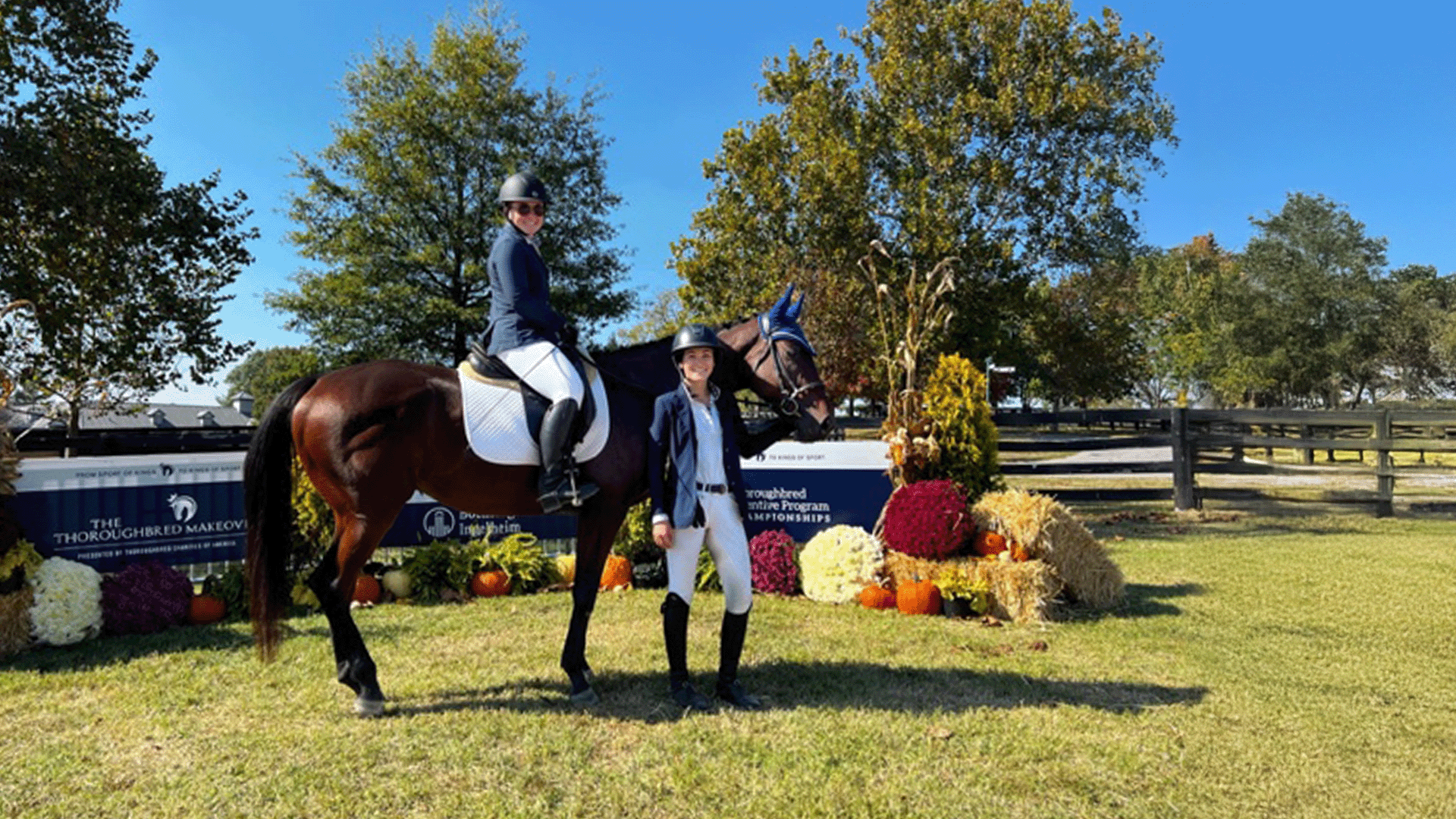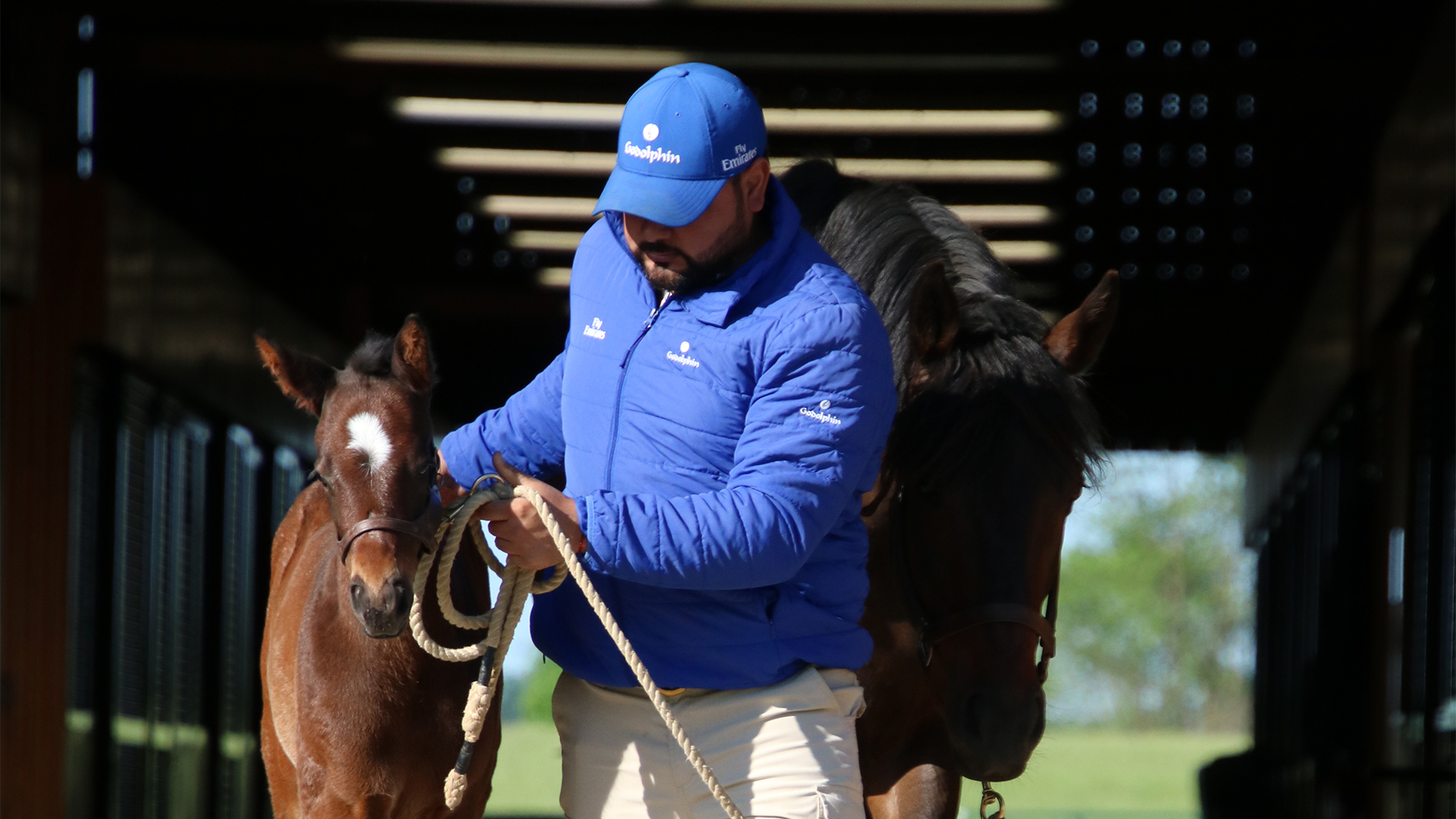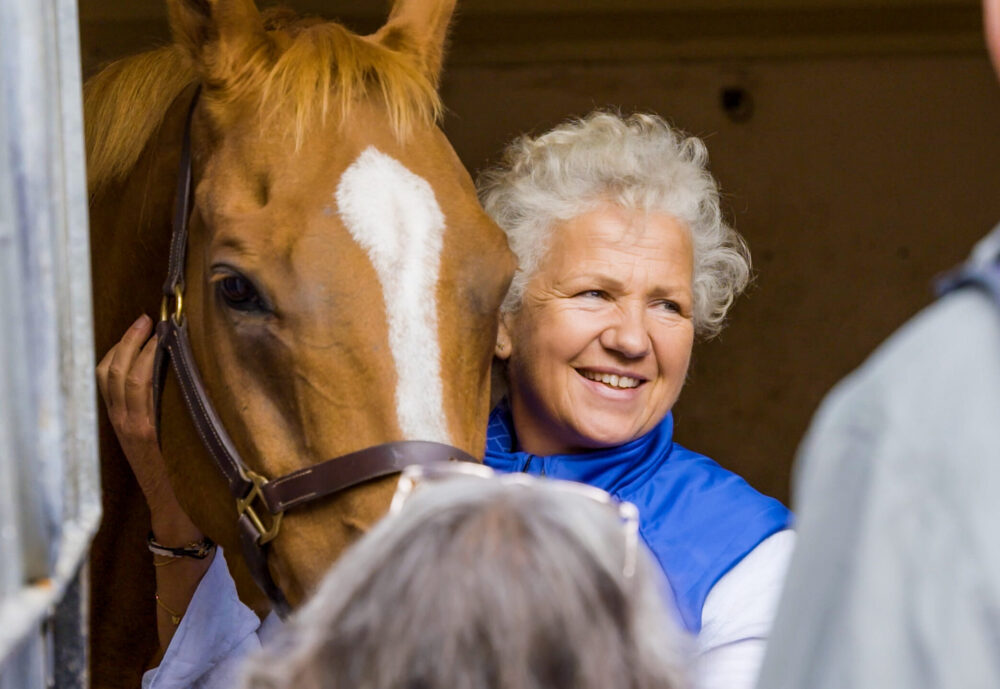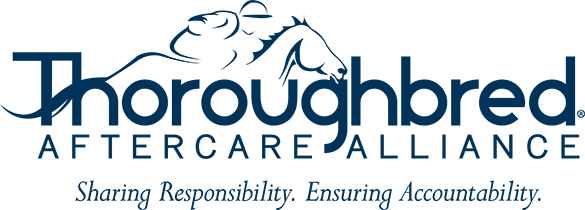Godolphin
All Posts & News Press Releases Success Stories Aftercare Editorials Retraining Tips Supporter Features Inspector Spotlights Humberger Toggle Menu Previous Post Moab’s Journey to the RRP Moab’s Journey to the RRP By: Alexis Arbaugh September 27, 2024 Retraining, Success Stories Tags:accredited aftercare, Godolphin, hunter jumper, Retired Racehorse Project, The Thoroughbred Makeover, Thoroughbred Aftercare, Thoroughbred Aftercare Alliance Moab was donated to The University of Findlay (UF) in the spring of 2023 by Godolphin, one of the world’s leading Thoroughbred breeding and racing operations. Godolphin, also a proud supporter of Thoroughbred Aftercare Alliance, is profoundly invested in the aftercare of Thoroughbreds. For years, Godolphin has supported UF’s breaking and retraining program by donating horses, highlighting their commitment to Thoroughbred aftercare. At the start of the fall semester, Ryanne, a junior in the English Equestrian Program, was assigned to work with Moab. In this program, students take full responsibility for a horse’s care and riding each semester. As they progress, students may be assigned multiple horses and are encouraged to break or retrain young horses after their freshman year. Moab, a 2020 bay gelding by Street Sense out of Skylighter, didn’t race but received some initial under-saddle training before arriving at UF. Ryanne felt relieved that she didn’t have to start from scratch, though retraining an ex-racehorse can still be challenging. Fortunately, this wasn’t Ryanne’s first experience working with a green or unbroken horse. During her sophomore year, she spent time at Findlay’s Western Farm, where she worked alongside students and trainers to break colts. Ryanne’s passion for horses began at age eight, starting with Hunter/Jumper lessons before progressing to dressage until she was 18. After high school, she enrolled at The University of Findlay and joined the English Equestrian Program, where she trained under the Hunter/Jumper coach. Most recently, Ryanne spent the summer in Wellborn, Florida, working with a variety of horses—broke, green, and unbroke—honing her skills with different levels of training. When Moab arrived at The University of Findlay, he was given time to settle into his new surroundings. By mid-August, his training with Ryanne began. Despite Moab’s calm demeanor on the ground, they approached the retraining process slowly and carefully. They worked in the detached indoor arena, where young and unbroke horses are started due to its quieter environment. Like all Findlay students, Ryanne began Moab’s training in the round pen to maintain better control. She started with lunging and eventually taught him how to line drive. Understanding the importance of forward motion in horse training, Ryanne focused on ensuring that Moab moved forward and responded to her aids, knowing that this would lay the foundation for further success. When Ryanne felt that Moab was ready to be ridden, she mounted him for the first time. Mounting can be tricky if the horse hasn’t been properly handled beforehand. To keep him calm, she had a classmate hold him while she mounted, helping Moab stay relaxed. Teaching him to stand still after mounting took time, but with patience, Moab eventually learned to wait for Ryanne’s cue to walk off. Now, mounting is easy and doesn’t faze either of them. After mounting, Ryanne’s priority was establishing forward movement and straightness. Encouraging forward motion helps the horse focus on “thinking forward” and paying attention to the rider’s aids. Straightness improves the horse’s balance and body awareness, helping them understand where all four legs are in relation to each other. These foundational elements are crucial for Moab’s training and overall responsiveness to Ryanne’s cues. While Moab’s under-saddle training progressed, Ryanne also focused on refining his ground manners. She introduced him to clippers and mane pulling, both of which he tolerated well, standing calmly during grooming sessions. They also worked on trailer loading, which he handled without any issues, further proving himself to be an all-around easy-going horse. Moab did have one quirky habit—he loved to put everything in his mouth. From blankets to Ryanne’s clothes, if it was within reach, Moab would try to chew on it. Like many young horses, this behavior stemmed from curiosity, as licking and chewing help them explore their surroundings. However, if left unchecked, it could lead to unwanted biting or nipping. Gradually, Moab began to learn that chewing on toys and treats was acceptable, but clothes—his or Ryanne’s—were off-limits. After achieving straightness, Ryanne focused on more advanced training, including teaching Moab to respond to bit pressure and use his body more efficiently. Moab excelled in these challenges, eagerly responding to Ryanne’s cues. Before long, he became strong enough to lift his back while being ridden and carry himself properly. He learned to bend and flex without losing balance, though it was more challenging for him at the trot and canter than at the walk. By taking things slow and steady, Moab was able to learn correctly, always showing a desire to do the right thing. At this stage, Ryanne recognized that Moab needed more mental stimulation. She decided to introduce ground poles as the next challenge in their preparation for the Retired Racehorse Project. Walking, trotting, and cantering over the poles didn’t bother Moab at all, so Ryanne began teaching him how to jump. Moab seemed to enjoy it, treating it like a fun game, so she continued raising the jumps and challenging him with more complex exercises and combinations. With the Retired Racehorse Project approaching, they worked diligently on lateral movements for the dressage test and perfected their 2’6″ fences for the show Hunter courses. Ryanne soon knew that Moab was ready to compete in The Retired Racehorse Project because his response time under saddle became quick and dependable. “There was no longer a conversation—I’d ask, and he’d respond with ‘yes ma’am,’” Ryanne wrote. Another sign of his readiness came when one of her classmates rode him, and Moab performed just as well for her as he did for Ryanne. It was clear that all the pieces of their training were falling into place, and Moab was fully prepared for the show. Competing at The Retired
Read More >All Posts & News Press Releases Success Stories Aftercare Editorials Supporter Features Inspector Spotlights Previous Post Godolphin’s Commitment to Lifetime Care of Thoroughbreds Godolphin’s Commitment to Lifetime Care of Thoroughbreds By: Jay Privman April 25, 2024 Supporter Feature Tags:Darley, Godolphin, Godolphin Lifetime Care, Industry Stakeholder, supporter, Supporter Feature, Thoroughbred Aftercare Alliance Supporter With a worldwide operation encompassing North America, Europe, Asia, and Australia, Godolphin is involved in Thoroughbred aftercare on many fronts, particularly in the United States, where Godolphin was in on the ground floor of the founding of Thoroughbred Aftercare Alliance and remains steadfast in its support to this day. “It’s like the Good Housekeeping seal,” said Jimmy Bell, who was president and racing manager for Godolphin USA when Thoroughbred Aftercare Alliance was founded and who is a past president of Thoroughbred Aftercare Alliance. “Facilities have to be inspected to be accredited. You’ve got to do something to get it, and you’ve got to do something to keep it.” “About 16,000 horses have come through the program. There’s 86 facilities currently accredited. Thoroughbred Aftercare Alliance has distributed more than $30 million,” Bell said. “Aftercare is important for the overall health of the industry. Not only is it a great story, it’s the right story.” At Godolphin’s United States headquarters in Kentucky, Katie LaMonica, Godolphin’s charities manager, worked closely with Bell prior to Bell’s retirement in late 2021, and she has been the point person for Godolphin regarding aftercare for more than a decade. “I remember when Thoroughbred Aftercare Alliance was founded. Jimmy had a meeting with me and said, ‘This is the way to go,’” LaMonica recalled. “The accreditation is what wins you over.” “Overall, aftercare – Godolphin calls it ‘lifetime care’ — has come so far. Things are in place now. With events like Thoroughbred Makeover, demand has been created. It has an impact.” Godolphin has a multi-pronged aftercare set-up, including its own Godolphin rehoming. Thoroughbred Aftercare Alliance is an essential aspect of Godolphin’s commitment to aftercare. “We’ve shown that these horses can have second careers. They are versatile,” LaMonica said. “And there’s a demand for them.” Among the former Godolphin runners who have gone to successful second careers is Hieronymous, named for G.D. Hieronymous, an Eclipse Award-winning broadcast production journalist who retired three years ago after 20 years as Keeneland’s director of broadcast services. The equine Hieronymous, a Godolphin homebred gelding who won 5 of 9 starts, including two stakes at Fair Grounds and one at Canterbury, won the competitive trail horse competition at Thoroughbred Makeover in 2022. He is now a “full-blown Western trail horse,” LaMonica said. Underscore, a homebred by Uncle Mo who was retired after one start, is now a dressage horse owned by Natalie Voss, the multiple Eclipse Award-winning journalist for the Paulick Report. “He’s doing awesome,” LaMonica said. “We strongly believe in Thoroughbred Aftercare Alliance,” LaMonica said. “We absolutely believe in their mission.” Asked if it was gratifying to see how far Thoroughbred Aftercare Alliance has come since inception, Bell said he preferred another word: “thankful.” “To know there are real second careers for these horses is very important,” he said. “It gives dignity to them. Roping, dressage, this, that, there are numerous things they can do, and it’s to everyone’s benefit.” Learn more about Thoroughbred Aftercare Alliance’s supporters: Industry Stakeholders Share This Article
Read More >Godolphin’s Lifetime Care Ensures Safety Net for Its Horses, Worldwide By: Alexandra Kokka Godolphin has cemented its place among Thoroughbred racing’s most renowned owners and breeders worldwide, demonstrating the possibility to achieve success at the highest level of the sport spanning four continents. The same world-class effort Sheikh Mohammed’s Godolphin has displayed in breeding and racing horses also applies to aftercare. The Thoroughbred Aftercare Alliance recently caught up with Godolphin’s strategic adviser for charities, Diana Cooper, to discuss the evolution of aftercare in the organization. “Since the very beginning of Godolphin, we have had an aftercare program that has evolved over the years,” Cooper recalled. “About seven years ago we became more proactive about formalizing the programs we had in each country under the Godolphin banner, and so the Godolphin Lifetime Care brand name came to fruition. Our objective is to create a greater awareness, passion, and care for these Thoroughbreds throughout their lives, to provide and encourage the best possible lifelong care.” Godolphin Lifetime Care representatives around the world were among those in attendance for these early meetings and annually hold court with aftercare and racing representatives. Every Thoroughbred who is a part of the flagship ownership entity has a safety net for the duration of its life, long after retiring from racing. “In each country where Godolphin operates, we have a lifetime care program that reflects the culture and fits in with the infrastructure of the industry in that country,” Cooper explained. “We are very proud to be able to promote the secondary careers of these horses around the world.” Because of differences in practices, policies, and demand for Thoroughbred aftercare among countries, GLC programs in Europe, Australia, United States, and Japan have individualized protocols. More than anything else, the depth of the GLC program depends on the level of preexisting aftercare infrastructure already in place in that racing jurisdiction. UNITED STATES In the U.S., Godolphin’s Lifetime Care program is overseen by Godolphin racing office and sales manager Emma Browne Lovatt, who has been under the Godolphin umbrella for 20 years. Although she wears many hats for the U.S. racing and breeding operation, Lovatt takes great pride in the success of the aftercare program. “The Lifetime Care program is a very important aspect of the business model: It’s part of the way we do business, and it has to be included in what we do,” Lovatt said. “Their racing career is the smallest part of their life, and we’ve got to try to ensure that the rest of their lives, whether it be the next 15 to 20 years, is somewhere they will be well taken care of.” Since 2014, Lovatt estimates she has helped rehome nearly 184 Godolphin horses. Horses are either rehomed directly following their letdown period or are transferred to an aftercare organization that provides retraining and adoption resources. “I have a wait-list of people interested in adopting Godolphin graduates—it’s ginormous,” Lovatt said. “I also use TAA-accredited New Vocations and the Secretariat Center.” Horses that transition through TAA-accredited organizations are protected under the TAA’s Code of Standards. Thanks to the preexisting infrastructure the TAA and its 81 accredited organizations provide, Godolphin horses that otherwise would be rehomed with no retraining have the opportunity to discover what discipline they are best suited for in building a foundation toward a second career. For example, Godolphin-trained gelding Regiment made two career starts and never broke his maiden. The decision was made to retire the son of Indian Charlie from racing, thus activating the next phase of his life—transitioning through the GLC program. Regiment spent six months in training at the Secretariat Center in Lexington, where it was quickly determined that, with the right adopter, “Reggie,” had the potential to be an upper-level eventer. Fast forward seven years to 2022, Regiment and adopter McKenzie Dey Cumbea have successfully completed numerous four-star events. EUROPE Across the pond sits Godolphin’s most in-depth Lifetime Care program, where retired racehorses receive rehabilitation as well as retraining for a second career. However, rehoming is not the only mission that the European Lifetime Care program serves. It also houses select retirees to help promote the path for retired racehorses. “In Europe our retraining program is based in the U.K.,” Cooper explained. “At our Newmarket retraining facility, we look after horses that have been particular friends to us. We retrain them, and they become our ambassadors.” Among the most beloved of the UK Lifetime Care program ambassadors is 2004 Ascot Gold Cup (G1) winner, Papineau. Just this fall, the now 22-year-old gelding launched the new school year at the Newmarket Academy, accompanied school children to pay their respects at the statue of Her Majesty The Queen, welcomed more than 790 visitors during the Sir Henry Cecil Open Weekend, and even brought joy to some patients at the Newmarket Hospital. “The horses that we’ve used for racehorse parades to be our flag-bearers include African Story and Prince Bishop, winners of the Dubai World Cup (G1), Ascot Gold Cup winner Papineau, and (trainer) Charlie Appleby’s Melbourne Cup (G1) winner, Cross Counter,” Cooper said. AUSTRALIA Similar to Godolphin’s efforts in America, the GLC program in Australia provides direct rehoming or retraining, depending on each horse’s needs. The southern hemisphere operation also maintains flag-bearers to represent Godolphin during race parades and open houses. “In Australia, the majority of horses that we rehome fit into programs that already exist,” Cooper explained. “These programs really suit the industry and adapt our horses as much as possible for their future careers. Hartnell was a champion racehorse and is now a champion in aftercare competitions.” JAPAN Yasuko Sawai has been with Godolphin for 16 years, first working in the Darley Japan foaling barn for 10 years before taking on the responsibility of managing the Japanese GLC program in 2015. “We do our Lifetime Care program two ways. One, we have a rehoming program for our racehorses and, two, we want to improve aftercare by educating racing people,” Sawa explained. “We have rehomed around
Read More >















